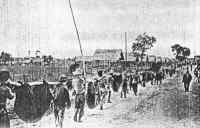Page 9
Civilians lined the roads and shouted greetings to the ragged army.
It bolstered their morale. The Japanese were angered by the rousing welcome
given to the POW’s and ordered the Filipinos back, but the crowds refused
to move. They continued cheering and throwing food to the prisoners.
This is where Russ got some sugar cane since the Filipinos threw panocha,
hardened sugar cane, to the marchers.
Russ was in one of the first groups moving out. He had wrapped tape
around his watch and would hit it with his hand as if to start it, so no
Jap took it. He had also scuffed his shoes and dented
his canteen so he could keep it - the Japanese only took shiny things.
He smuggled a straight razor through in a small bag by
asking if "knife okay?" and showing the guards a tiny knife that came out
of crackerjacks. When the Japs would grab his bag to search
it, he would pull out the tiny knife and while they were distracted,
he would put his things back in the bag and move along. He
also sewed $1,600 into his jacket and took it through the prison camps.
It helped buy medicine and food for him and others. He loaned some to other
men who promised to pay him back, but he never heard from any of them after
the war.
The Geneva Prisoner of War
Convention set the normal days march at 12 and 1/2 miles unless the
necessity of reaching water and food requires longer
stages. The Japanese assumed that all the captives
could be brought together at Balanga in a day or less. The next
feeding point above Balanga was the town of Orani, about 8
miles at the base of Bataan peninsula. Then 5 miles further to the
northwest at San Fernando, the captives would have their last meal before
a short train ride to internment camp. There were to be two field hospitals
each to accommodate 500 to 1,000 patients.
While the Japanese plan called for the prisoners to move on foot
as far as Balanga, it did not specify how the captives would travel the
thirty-one miles from that point to San Fernando. It was apparent
they would walk. The end of the journey would be Camp O'Donnell,
a former temporary Philippine Army post.
Under the best of circumstances the Japanese plan would have been difficult to execute. The assembly, organization and march
from Bataan to Camp O'Donnell of thousands of American and
Filipino prisoners of war was a demanding operation. It proved to be a
horrible episode.
been difficult to execute. The assembly, organization and march
from Bataan to Camp O'Donnell of thousands of American and
Filipino prisoners of war was a demanding operation. It proved to be a
horrible episode.
The Japanese had the task of feeding and caring for their sick and wounded.
Their force totaled nearly 81,000 and their supplies were exceedingly scarce.
The march began slowly because most were barely able to stagger.
When men collapsed and died they were left or buried where they fell.
Columns of prisoners continued to leave until the 17th of April and it
was the 23rd before the last of the men deported.
The men marched in an aimless, confused fashion. One group sat
in the hot sun without food or water until mid afternoon. The ditches were
strewn with burned trucks, battered artillery pieces,
abandoned equipment and rotting bodies. Adding to this confusion
were hundreds of Filipino civilian refugees seeking to find their way north.
|